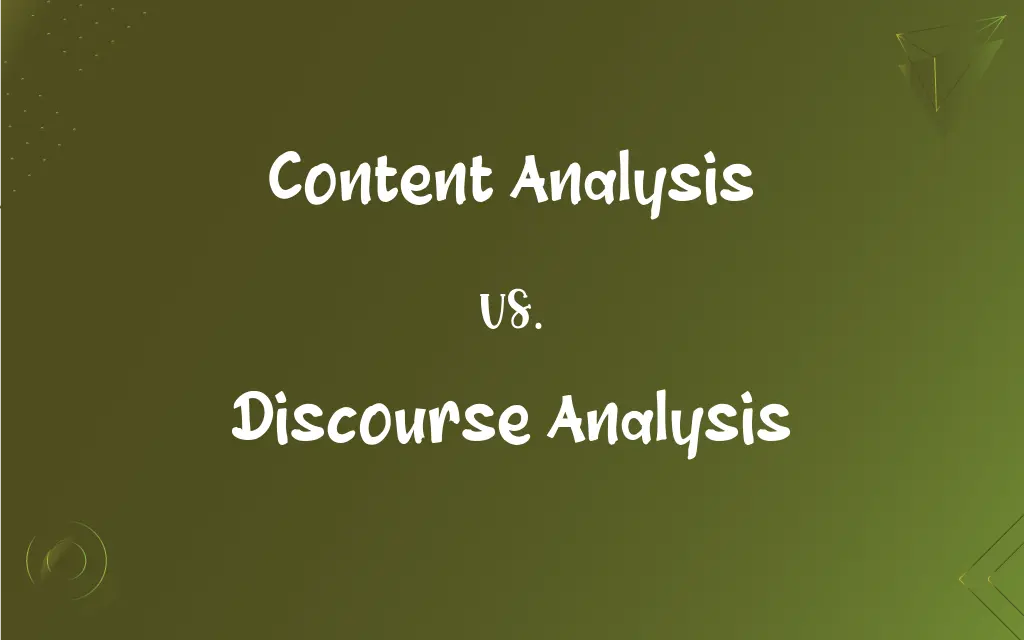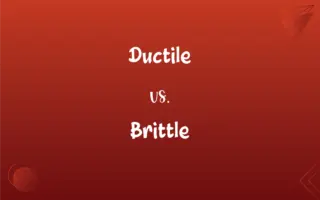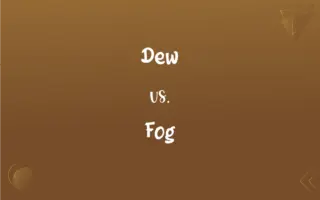Content Analysis vs. Discourse Analysis: What's the Difference?
Edited by Janet White || By Harlon Moss || Published on November 22, 2023
Content analysis quantitatively examines media content, focusing on the frequency of specific terms or themes. Discourse analysis qualitatively studies language in use, emphasizing the meanings and relationships in communication.

Key Differences
Content analysis is a research method employed primarily to quantify and analyze the presence, meanings, and relationships of certain words, themes, or concepts within a given text or set of texts. Discourse analysis, on the other hand, is a qualitative method that delves deeper into how language constructs meaning, power relations, and social identities in various social contexts.
While content analysis often involves counting the number of times a word or phrase appears to draw patterns, discourse analysis is more concerned with the nuances, structures, and patterns of speech or written texts, aiming to uncover the underlying social and cultural contexts.
The primary objective of content analysis is to transform qualitative data into quantitative data, enabling researchers to discern patterns and make broader generalizations. In contrast, discourse analysis seeks to interpret the qualitative data, focusing on the deeper structures of language to uncover hidden meanings and societal norms.
A key distinction lies in the approach: content analysis is typically deductive, starting with a theory or hypothesis and examining the content to confirm or refute it. Discourse analysis, however, is often inductive, beginning with the content and drawing out theories or themes based on the analysis.
Both methodologies are useful in their own right. While content analysis provides a broad overview of patterns and trends in a large set of texts, discourse analysis provides a more detailed, nuanced understanding of the way language functions in specific instances.
ADVERTISEMENT
Comparison Chart
Nature
Quantitative
Qualitative
Focus
Frequency of words, themes, or concepts.
Meanings and relationships in language.
Objective
Transform qualitative data into quantitative data.
Interpret qualitative data and uncover deeper structures.
Approach
Deductive: Starts with a hypothesis.
Inductive: Builds theories from content.
Interpretation Level
Surface-level patterns in content.
Deeper understanding of language functions and contexts.
ADVERTISEMENT
Content Analysis and Discourse Analysis Definitions
Content Analysis
A method to discern patterns within textual or visual materials.
By using content analysis, the team identified recurring motifs in Renaissance paintings.
Discourse Analysis
The study of language beyond the sentence, focusing on context and meaning.
Through discourse analysis, the researcher interpreted the subtext in the novel's dialogues.
Content Analysis
A research tool used to determine the presence of certain words or concepts within texts.
Content analysis of political speeches unveiled trends in policymakers' priorities.
Discourse Analysis
A method to analyze communicative events considering social, cultural, and political factors.
A discourse analysis of advertisements highlighted societal beauty standards.
Content Analysis
A systematic research method for analyzing textual information.
Through content analysis, researchers found that violence is portrayed in 30% of the cartoons.
Discourse Analysis
A method exploring the use of language and its social implications.
Discourse analysis of classroom interactions revealed power dynamics between students and teachers.
Content Analysis
A technique for converting qualitative data into quantitative data.
Content analysis of fan letters showed a recurring theme of admiration for the artist.
Discourse Analysis
An examination of language in use, emphasizing relationships and power dynamics.
Discourse analysis unveiled subtle forms of sexism in workplace communication.
Content Analysis
The study of documented communication to determine the frequency of specific terms, topics, or concepts.
A content analysis of newspapers revealed an increase in climate change coverage.
Discourse Analysis
A technique for examining linguistic structures in relation to social and cultural contexts.
Discourse analysis of a debate showed underlying cultural biases influencing the participants.
FAQs
Does content analysis focus on qualitative or quantitative data?
Content analysis primarily focuses on quantitative data.
Does discourse analysis consider the cultural context of language?
Yes, discourse analysis deeply considers cultural, social, and political contexts.
Can content analysis provide insights into societal trends?
Yes, content analysis can reveal patterns and trends in media content reflecting societal shifts.
Is discourse analysis always subjective?
While interpretative, discourse analysis uses systematic methods to ensure analytical rigor.
Which method is more concerned with the "how" of communication?
Discourse analysis is more concerned with the "how" and "why" aspects of communication.
Which analysis method is more deductive: content analysis or discourse analysis?
Content analysis is typically more deductive in nature.
Is it possible to combine both content analysis and discourse analysis in a single study?
Yes, combining both can provide comprehensive insights, with content analysis identifying patterns and discourse analysis interpreting them.
How does content analysis categorize information?
Content analysis uses coding schemes to categorize and quantify information systematically.
What is the main objective of discourse analysis?
Discourse analysis seeks to interpret language and uncover deeper structures of meaning.
Which method requires a deeper understanding of linguistic nuances?
Discourse analysis requires a deeper grasp of linguistic nuances and contexts.
Is discourse analysis limited to spoken language?
No, discourse analysis can be applied to both spoken and written language.
In which situations is discourse analysis particularly useful?
Discourse analysis is useful when examining societal norms, power relations, and underlying meanings in language.
Can discourse analysis provide insights into societal biases?
Yes, discourse analysis can reveal societal biases and assumptions embedded in language.
What tools are commonly used in content analysis?
Both manual coding and software tools can be used in content analysis.
Can content analysis study the sentiment of texts?
Yes, content analysis can be used to gauge the sentiment or emotional tone of texts.
Can content analysis be used to study visual content?
Yes, content analysis can be applied to both textual and visual materials.
Which analysis method can help identify recurring themes in a dataset?
Content analysis is well-suited for identifying recurring themes by quantifying their occurrences.
How does content analysis handle large sets of data?
Content analysis effectively handles large data sets by categorizing and quantifying specific terms or themes.
What's a key benefit of discourse analysis in media studies?
Discourse analysis can uncover how media shapes perceptions and societal norms through language.
Can discourse analysis reveal power dynamics in language?
Absolutely, discourse analysis often uncovers power relations and social hierarchies in language.
About Author
Written by
Harlon MossHarlon is a seasoned quality moderator and accomplished content writer for Difference Wiki. An alumnus of the prestigious University of California, he earned his degree in Computer Science. Leveraging his academic background, Harlon brings a meticulous and informed perspective to his work, ensuring content accuracy and excellence.
Edited by
Janet WhiteJanet White has been an esteemed writer and blogger for Difference Wiki. Holding a Master's degree in Science and Medical Journalism from the prestigious Boston University, she has consistently demonstrated her expertise and passion for her field. When she's not immersed in her work, Janet relishes her time exercising, delving into a good book, and cherishing moments with friends and family.































































